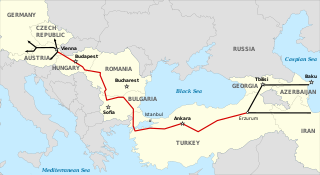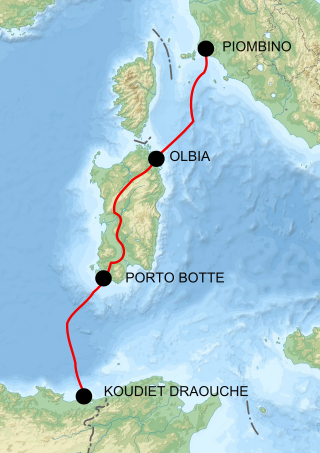
Eni S.p.A. is an Italian multinational energy company headquartered in Rome. One of the "supermajor" oil companies in the world, with a market capitalization of €48 billion, as of 31 December 2022. The Italian government owns a 30.33% golden share in the company, 4.37% held through the Ministry of Economy and Finance and 25.96% through the Cassa Depositi e Prestiti. The company is a component of the Euro Stoxx 50 stock market index.
Nord Stream is a pair of offshore natural gas pipelines in Europe that run under the Baltic Sea from Russia to Germany. It comprises the Nord Stream 1 (NS1) pipeline running from Vyborg in northwestern Russia, near Finland, and the Nord Stream 2 (NS2) pipeline running from Ust-Luga in northwestern Russia near Estonia. Both pipelines run to Lubmin in the northeastern German state of Mecklenburg-Vorpommern. Each pipeline comprises two pipes, denoted A and B; each of the four pipes is approximately 1,200 kilometres (750 mi) long and with approximate diameters of 1,220 millimetres (48 in). The combined capacity of the four pipes is 110 billion cubic metres per annum of natural gas.

The Nabucco pipeline was a failed natural gas pipeline project from Erzurum, Turkey to Baumgarten an der March, Austria to diversify natural gas suppliers and delivery routes for Europe. The pipeline was to lessen European dependence on Russian energy. The project was backed by several European Union states and the United States and was seen as rival to the Gazprom-Eni South Stream pipeline project. The main supplier was to be Iraq with potential supplies from Azerbaijan, Turkmenistan, and Egypt.

The Burgas–Alexandroupoli pipeline was a proposed oil pipeline project for transportation of Russian and Caspian oil from the Bulgarian Black Sea port of Burgas to the Greek Aegean port of Alexandroupoli. It was seen as an alternative route for Russian oil, bypassing the Bosporus and the Dardanelles. However, in December 2011 the project was suspended by the Bulgarian government due to environmental and supply concerns.

The Ünye–Ceyhan pipeline, commonly known with its former name, the Samsun–Ceyhan pipeline, was a planned crude oil pipeline traversing Turkey from the Black Sea to the Mediterranean oil terminal in Ceyhan. The aim of the project was to provide an alternative route for Russian and Kazakhstani oil and to ease the traffic burden in the Bosphorus and the Dardanelles. The project was halted in 2010. This was confirmed again in 2013.
The BBL Pipeline is a natural gas interconnector between the Netherlands and the United Kingdom.

The South Caucasus Pipeline is a natural gas pipeline from the Shah Deniz gas field in the Azerbaijan sector of the Caspian Sea to Turkey. It runs parallel to the Baku–Tbilisi–Ceyhan pipeline (oil).

Medgaz is a submarine natural gas pipeline between Algeria and Spain.

GALSI was a planned natural gas pipeline from Algeria to Sardinia and further northern Italy, as an extension to the TransMed Pipeline.

The Greenstream pipeline, part of the Western Libyan Gas Project, is a natural gas submarine pipeline running from western Libya to the island of Sicily in Italy.

The Trans-Mediterranean Pipeline is a natural gas pipeline from Algeria via Tunisia to Sicily and thence to mainland Italy. An extension of the TransMed pipeline delivers Algerian gas to Slovenia.
The Trans-Balkan pipeline is a natural gas pipeline between Turkey and Ukraine with branches to Greece and North Macedonia. It was used by Gazprom for gas deliveries through Balkan countries to Turkey. Before construction of the Blue Stream pipeline it was the only international natural gas pipeline supplying Turkey.

South Stream was a canceled pipeline project to transport natural gas of the Russian Federation through the Black Sea to Bulgaria and through Serbia, Hungary and Slovenia further to Austria. It was never finished.
The Dolphin Gas Project is the natural gas project of Qatar, the United Arab Emirates, and Oman. It is the Gulf Cooperation Council's first cross-border refined gas transmission project and the largest energy-related venture ever undertaken in the region.
Saipem S.p.A. is an Italian multinational company that operates as a contractor in the oil and gas industry, particularly in remote and deepwater locations. Founded in 1957, it has established its headquarters in Milan, Italy. As a leader in engineering, procurement, construction (EPC), and drilling services, Saipem specializes in the design, construction, and operation of complex, safe, and sustainable infrastructures and plants worldwide.
Yamal project, also referred to as Yamal megaproject, is a long-term plan to exploit and bring to the markets the vast natural gas reserves in the Yamal Peninsula, Russia. Administratively, the project is located in the Yamalo-Nenets Autonomous Okrug.
Durusu Terminal is a gas metering station in Turkey, located in Çarşamba district, nearly 60 km (37 mi) from the city of Samsun. The terminal is virtually on the sea side, in the immediate vicinity of surfacing of the Blue Stream sub-sea natural gas pipeline. The approximate size of the Durusu Terminal is 20 hectares. It is an integral component of the Russian-Turkish Blue Stream project
TurkStream is a natural gas pipeline running from Russia to Turkey. It starts from Russkaya compressor station near Anapa in Russia's Krasnodar Region, crossing the Black Sea to the receiving terminal at Kıyıköy.

Fossil gas supplies over a quarter of Turkey's energy. The country consumes 50 to 60 billion cubic metres of this natural gas each year, nearly all of which is imported. A large gas field in the Black Sea however started production in 2023.













